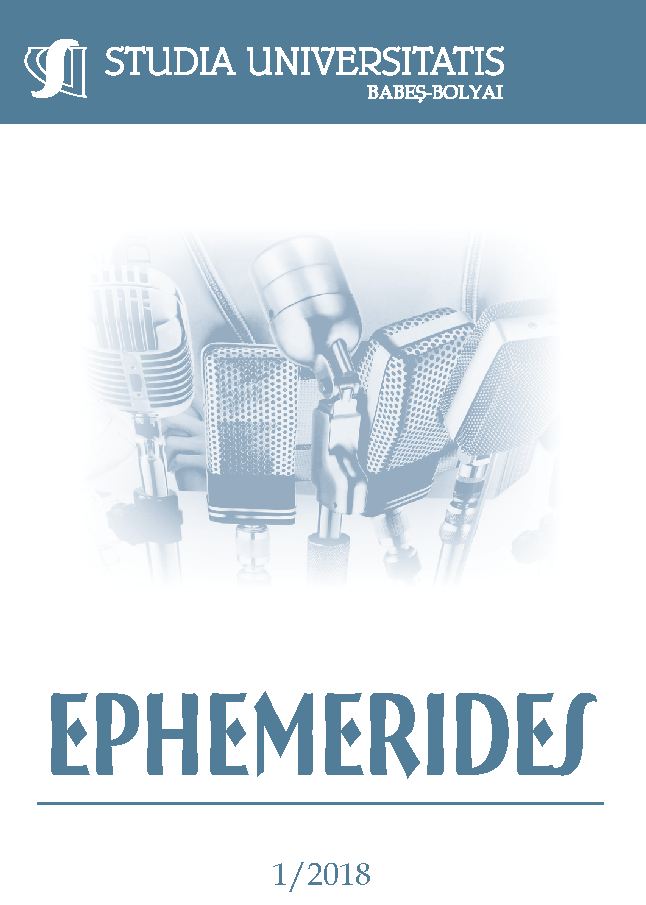WHY DO WE SHARE. AN INTERDISCIPLINARY PERSPECTIVE
DOI:
https://doi.org/10.24193/subbeph.2018.1.02Keywords:
share, communication, content, social capital, dopamine, activation, novelty, behaviourAbstract
This study focuses on explaining why people decide to share information online and what are the factors that influence what content we distribute using the latest scientific papers in Psychology, Sociology, Neurosciences and Communication.References
ALLEN, Mike. „Sean Parker unloads on Facebook: «God only knows what it’s doing to our children’s brains»“. Axios.com, Nov 9, 2017. https://www.axios.com/sean-parker-unloads-on-facebook-god-only-knows-what-its-doing-to-our-childrens-brains-1513306792-f855e7b4-4e99-4d60-8d51-2775559c2671.html
ARISTOTLE. „Politics” translated by El Bezdechi. Editura Cultura Naţională, 1924.
BENTON, Joshua, „The leaked New York Times Innovation report is one of the key documents of this media age”. Niemanlab.org, May 15, 2014, http://www.niemanlab.org/2014/05/the-leaked-new-york-times-innovation-report-is-one-of-the-key-documents-of-this-media-age/
BERGER, Jonah. „Arousal Increases Social Transmission of Information”. Psychological Science, Vol 22, Issue 7, pp. 891 – 893, June 20, 2011. https://doi.org/10.1177/0956797611413294
BoundlessMind. 2018. „BoundlessMind case studies”.https://s3-us-west-2.amazonaws.com/boundless-documents-public/CaseStudies/BoundlessMindCaseStudies.pdf
BOURDIEU, Pierre, LOÏC J.D. Wacquant. „An Invitation to Reflexive Sociology”. University of Chicago Press, 1992.
BOWLES, Nellie. „Early Facebook and Google Employees Form Coalition to Fight What They Built”. The New York Times, Feb. 4, 2018. https://www.nytimes.com/2018/02/04/technology/early-facebook-google-employees-fight-tech.html
BROOKS, David. „How Evil Is Tech?” The New York Times. https://www.nytimes.com/2017/11/20/opinion/how-evil-is-tech.html
COGHLAN, Andy. „Brain’s reward system earns researchers €1 million prize.” New Scientist. https://www.newscientist.com/article/2123578-brains-reward-system-earns-researchers-e1-million-prize/.
DOMJAN, M. „The Principles of Learning and Behavior”. Wadsworth Publishing Company. 2009. 6th Edition. pages 244–249.
HERMIDA, Alfred. „Tell Everyone: Why We Share and Why It Matters”. Doubleday Canada, 2014.
HOPSON, John. 2001. „Behavioral Game Design”. Gamasutra.com. http://www.gamasutra.com/view/feature/131494/behavioral_game_design.php
HOPSON, John. 2002. „The Psychology of Choice. Gamasutra”. http://www.gamasutra.com/view/feature/131420/the_psychology_of_choice.php
Information. Psychological Science 22(7) 891–893. DOI: 10.1177/0956797611413294
KOENIG, F. „Rumor in the marketplace: The social psychology of hearsay”. Dover, Mass: Auburn House Pub. Co, 1985.
KONINGSBRUGGEN Guido M., HARTMANN Tilo, EDEN Allison and VELING Harm. „Spontaneous Hedonic Reactions to Social Media Cues”. Cyberpsychology, Behavior, and Social Networking Vol. 20, No. 5, 2017. https://doi.org/10.1089/cyber.2016.0530
LI, S., and CHUNG, T. „Internet function and internet addictive behavior”. Comput. Hum. Behav, 2006. 22, 1067–1071. doi: 10.1016/j.chb.2004.03.030
LIEBERMAN, Matthew D; FALK, Emily B; MORELLI, Sylvia A; WELBORN, B. Locke; DAMBACHER, Karl; CREATING Buzz, The Neural Correlates of Effective Message Propagation, Journal of Psychological Science, 2013.
LOPEZ-FERNANDEZ, O., HONRUBIA-SERRANO, L., FREIXA-BLANXART, M., and GIBSON, W. (2014). „Prevalence of problematic mobile phone use in British adolescents”. CyberPsychol. Behav. Soc. Netw. 17, 91–98. doi: 10.1089/cyber.2012.0260
MILKMAN, Katherine; REES-JONES, Liz; BERGER, Jonah, The Secret to Online Success: What Makes Content Go Viral, Scientific American Journal, April 14, 2015. Monographs, 70(Whole No. 416) of commercial hearsay. Dover, MA: Auburn House.
New York Times, Consumer Insight Group. „The Psychology of Sharing – Why do people share online”. http://nytmarketing.whsites.net/, 2015).
Organizația Mondială a Sănătății. 2018. „Gaming disorder”. http://www.who.int/features/qa/gaming-disorder/en/
PALAUS Marc, MARRON Elena M., VIEJO-SOBERA Raquel, REDOLAR-RIPOLL Diego. 2017. „Neural Basis of Video Gaming: A Systematic Review. Frontiers in Human Neuroscience, volume 11, https://www.frontiersin.org/article/10.3389/fnhum.2017.00248
POPA, Marcel D. et all, „Dicționar enciclopedic”, Editura Enciclopedică, 1993.
PUTNAM, Robert. „Bowling Alone: The Collapse and Revival of American Community”. Simon & Schuster New York, 2000.
SCHÜLL, Natasha Dow. „Addiction by Design: Machine Gambling in Las Vegas”. Princeton: Princeton University Press. 2012
SCHULL, Natasha. „Digital Gambling: The Coincidence of Desire and Design”. The Annals of the American Academy of Political and Social Science. 2005. DOI: 10.1177/000271620427043
SCHULTZ, Wolfram, DICKINSON, Anthony, „Neuronal Coding of Prediction Errors”. Annual Review of Neuroscience, 2000 23:1, 473-500, https://www.annualreviews.org/doi/10.1146/annurev.neuro.23.1.473
SKINNER, B.F. „A Matter of Consequences.” New York: Alfred A. Knopf, Inc., 1983.
SKINNER, B.F. „Science and human behavior”. SimonandSchuster, 1953.
SOROUSH Vosoughi, DEB ROY, Sinan Aral. „The spread of true and false news online”. Science, 09 Mar 2018. Vol. 359, Issue 6380, pp. 1146-1151. DOI: 10.1126/science.aap9559
TAMIR, I.P. Diana, MITCHELL, Jason, „Disclosing information about the self is intrinsically rewarding.” Proceedings of the National Academy of Sciences, vol. 109 no. 21, 2012.
TWENGE, J.M. „IGen: Why Today’s Super-Connected Kids Are Growing Up Less Rebellious, More Tolerant, Less Happy–and Completely Unprepared for Adulthood–and What That Means for the Rest of Us”. Simon and Schuster New York, NY. 2017.
VEISSIÈRE, Samuel P.L., Stendel Moriah. „Hypernatural Monitoring: A Social Rehearsal Account of Smartphone Addiction.” Frontiers in Psychology, VOL. 9, 2018, DOI=10.3389/fpsyg.2018.00141
World Health Organization, Gaming behaviour, http://www.who.int/substance_abuse/activities/gaming_disorders/en/
Downloads
Published
How to Cite
Issue
Section
License
Copyright (c) 2018 Studia Universitatis Babeș-Bolyai Ephemerides

This work is licensed under a Creative Commons Attribution-NonCommercial-NoDerivatives 4.0 International License.



